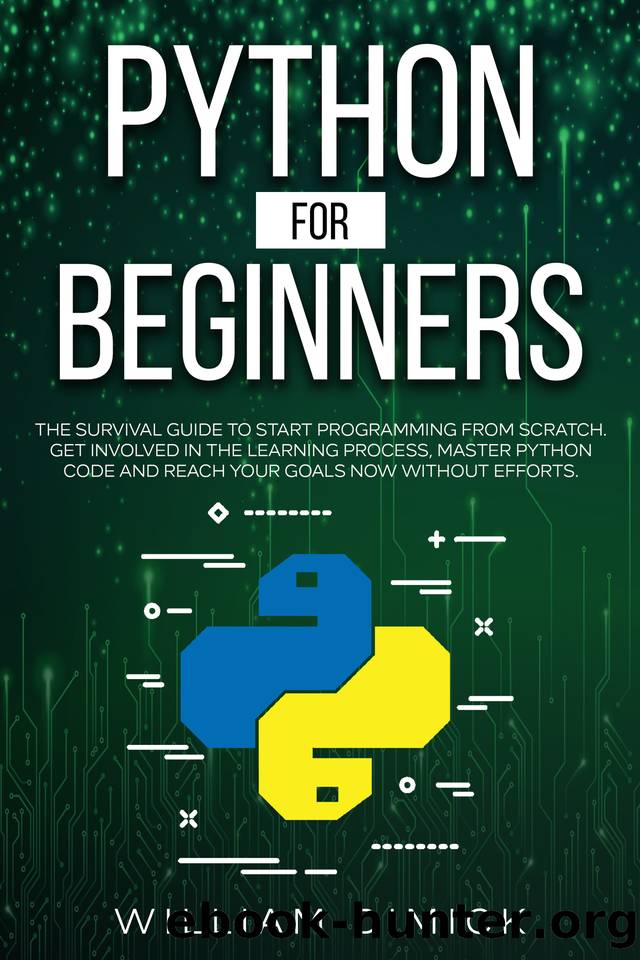Python for beginners: The survival guide to start programming from scratch. Get involved in the learning process, master Python code and reach your goals now without efforts. by William Dimick

Author:William Dimick [Dimick, William]
Language: eng
Format: azw3, epub
Published: 2020-09-24T00:00:00+00:00
Give this a shot before you look below for an answer to this exercise prompt.
If youâve given this a shot, your answer might look something like this:
favorite_food = input ("What's your favorite food? :")
favorite_animal = input ("What about your favorite animal? :")
favorite_movie = input ("What's the best movie? :")
print ("Favorite food is: " + favorite_food + "
" +
"Favorite animal is: " + favorite_animal + "
" +
"Favorite movies is: " + favorite_movie)
Weâve covered a lot of ground in the first quarter of this book. Weâll begin covering some more complex topics and concepts. However, before we move on, letâs be sure that weâve got the basics down. You wonât learn the new concepts unless you are familiar with what weâve covered so far, so for that reason, let's do a quick review of what weâve learned so far:
Variables - Variables are representations of values. They contain the value and allow the value to be manipulated without having to write it out every time. Variables must contain only letters, numbers, or underscores. In addition, the first character in a variable cannot be a number, and the variable name must not be one of Pythonâs reserved keywords.
Operators - Operators are symbols which are used to manipulate data. The assignment operator (=) is used to store values in variables. Other operators in Python include: the addition operator (+), the subtraction operator (-), the multiplication operator (*), the division operator (/), the floor division operator (//), the modulus operator (%), and the exponent operator (**). The mathematical operators can be combined with the assignment operator. (Ex. +=, -=, *=).
Strings - Strings are text data, declared by wrapping text in single or double-quotes. There are two methods of formatting strings; with the modulus operator or the. format () command. The âs,â âd,â and âfâ modifiers are used to specify the placement of strings, integers, and floats.
Integers - Integers are whole numbers, numbers that possess no decimal points or fractions. Integers can be stored in variables simply by using the assignment operator.
Floats - Floats are numbers that possess decimal parts. The method of creating a float in Python is the same as declaring an integer, just choose a name for the variable and then use the assignment operator.
Type Casting - Type casting allows you to convert one data type to another if the conversion is feasible (non-numerical strings cannot be converted into integers or floats). You can use the following functions to convert data types: int (), float (), and str ().
Lists - Lists are just collections of data, and they can be declared with brackets and commas separating the values within the brackets. Empty lists can also be created. List items can be accessed by specifying the position of the desired item. The append () function is used to add an item to a list, while the del command and remove () function can be used to remove items from a list.
List Slicing - List slicing is a method of selecting values from a list. The item at the first index is included, but the item at the second index isnât.
Download
Python for beginners: The survival guide to start programming from scratch. Get involved in the learning process, master Python code and reach your goals now without efforts. by William Dimick.epub
This site does not store any files on its server. We only index and link to content provided by other sites. Please contact the content providers to delete copyright contents if any and email us, we'll remove relevant links or contents immediately.
Hello! Python by Anthony Briggs(10193)
The Mikado Method by Ola Ellnestam Daniel Brolund(10106)
OCA Java SE 8 Programmer I Certification Guide by Mala Gupta(10041)
Algorithms of the Intelligent Web by Haralambos Marmanis;Dmitry Babenko(8585)
Sass and Compass in Action by Wynn Netherland Nathan Weizenbaum Chris Eppstein Brandon Mathis(7965)
Grails in Action by Glen Smith Peter Ledbrook(7940)
Test-Driven iOS Development with Swift 4 by Dominik Hauser(7898)
The Well-Grounded Java Developer by Benjamin J. Evans Martijn Verburg(7836)
Windows APT Warfare by Sheng-Hao Ma(7645)
Layered Design for Ruby on Rails Applications by Vladimir Dementyev(7378)
Blueprints Visual Scripting for Unreal Engine 5 - Third Edition by Marcos Romero & Brenden Sewell(7284)
Secrets of the JavaScript Ninja by John Resig Bear Bibeault(6736)
Kotlin in Action by Dmitry Jemerov(5367)
Solidity Programming Essentials by Ritesh Modi(4462)
Hands-On Full-Stack Web Development with GraphQL and React by Sebastian Grebe(4400)
WordPress Plugin Development Cookbook by Yannick Lefebvre(4272)
Unity 3D Game Development by Anthony Davis & Travis Baptiste & Russell Craig & Ryan Stunkel(4179)
Functional Programming in JavaScript by Mantyla Dan(4166)
The Ultimate iOS Interview Playbook by Avi Tsadok(4155)
